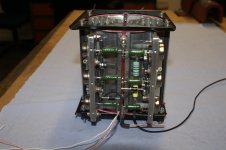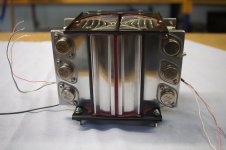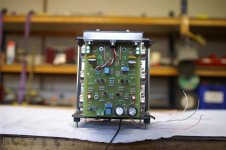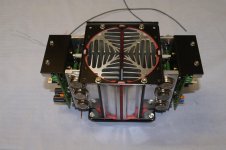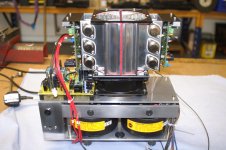Hi everyone, I have built a Krell KSA 50 with the aid of the thread that was started by BRA in Dec. 2002. I have used Jan Dupont PCB's and have now settled on fan cooling for the output stage. The bias and offset set up very easily and all looks good. I had assumed that the bias would alter slightly depending on the heatsink temperature, eg if the heatsink temperature rose above its normal operating temperature the bias would reduce and the heatsink temperature would fall to maintain a balance.
I have found the reverse to be true.When the heatsink is at normal temperature and the bias has been stable for a long time if I reduce the cooling fan speed slightly the heatsink temp. obviosly rises and I have noticed that the bias also rises producing even more heat. I have obviosly not let the cycle continue.
Can the operation of Q107, Q108 and Q111 be explained please. On my PCB's Q111 is mounted with the drivers Q109, Q110 on the main output stage heatsink. Q107, Q108 are free standing on the board.
My fear is that the bias will alter depending on ambiant temp eg if the bias was set during the winter months would it then increase during warmer weather and lead to thermal run away.
Thanks for your help
Alan
I have found the reverse to be true.When the heatsink is at normal temperature and the bias has been stable for a long time if I reduce the cooling fan speed slightly the heatsink temp. obviosly rises and I have noticed that the bias also rises producing even more heat. I have obviosly not let the cycle continue.
Can the operation of Q107, Q108 and Q111 be explained please. On my PCB's Q111 is mounted with the drivers Q109, Q110 on the main output stage heatsink. Q107, Q108 are free standing on the board.
My fear is that the bias will alter depending on ambiant temp eg if the bias was set during the winter months would it then increase during warmer weather and lead to thermal run away.
Thanks for your help
Alan
Attachments
Hi all, I was hoping that someone who constructed the KSA50 from the builders thread could help me understand why the bias current increases if the usual operating temperature of the heatsink is raised, by say slowing the cooling fan down. I was under the impression that the current should decrease and hence not allow thermal runaway.
If I am under a mishaprehension could someone enlighten me. (Andrew T, Jacco Vermeulen, Stuart Easson, K Amps, + lots more)
Thanks
Alan
If I am under a mishaprehension could someone enlighten me. (Andrew T, Jacco Vermeulen, Stuart Easson, K Amps, + lots more)
Thanks
Alan
Some Questions,
Are you using same devices and values as in circuit diagram.
What supply voltages are you using.
Did you make sure that Q111 is on same heatsink as Q201,202,203,204.
What size resistor did you use for R124.
What are your quiescent bias current.
Does R205 get warm.
Regards
Are you using same devices and values as in circuit diagram.
What supply voltages are you using.
Did you make sure that Q111 is on same heatsink as Q201,202,203,204.
What size resistor did you use for R124.
What are your quiescent bias current.
Does R205 get warm.
Regards
Thanks for the reply Vostro.
All transistors are the same as on the diagram.
The supply voltage is plus and minus 25 volts. I do not require the 50 watts RMS of the Krell running on 37 volt rails, or the ammount of heat dissapation. The only circuit alterations to accomodate 25 V rails were to the Zeners and their associate resistors in the VAS to keep the operating current of that stage correct.
Q111 is mounted on the same heatsink as the output transistors, as are the drivers Q108, Q109.
R124 is 4.7K
I am using 3 pairs of output transistors per channel. The quiescent current is set to 240mV across emmitter resistors that are 0.5 Ohm. At 8 Ohm load that gives me just over 30 watts class A RMS and a heat dissapation of about 70W per channel.
The amplifier sets up easily with 0v offset and the quiescent current reaches 240mV within 10 minutes of switch on from "cold" and stays steady within a few millivolts.
It is just that I thought that if the temperature of Q111 rose the current would reduce to keep balance, perhaps my assumption is wrong
Thanks
Alan
All transistors are the same as on the diagram.
The supply voltage is plus and minus 25 volts. I do not require the 50 watts RMS of the Krell running on 37 volt rails, or the ammount of heat dissapation. The only circuit alterations to accomodate 25 V rails were to the Zeners and their associate resistors in the VAS to keep the operating current of that stage correct.
Q111 is mounted on the same heatsink as the output transistors, as are the drivers Q108, Q109.
R124 is 4.7K
I am using 3 pairs of output transistors per channel. The quiescent current is set to 240mV across emmitter resistors that are 0.5 Ohm. At 8 Ohm load that gives me just over 30 watts class A RMS and a heat dissapation of about 70W per channel.
The amplifier sets up easily with 0v offset and the quiescent current reaches 240mV within 10 minutes of switch on from "cold" and stays steady within a few millivolts.
It is just that I thought that if the temperature of Q111 rose the current would reduce to keep balance, perhaps my assumption is wrong
Thanks
Alan
Alibear do not despair you did not build a temperature controller but an amplifier. In an earlier paragraph you say quiescent current settles in about 10 minutes from cold. So there, it stabilized after reaching some predefined heat sink temperature.
Okay so now you turn the fan off, something has to change and that is heat sink temperature rising. The new quiescent current will stabilize again when equilibrium is reached. Provided of course that the generated power does not exceed the heat sink capability to dissipate the power into the air.
If however the quiescent current keeps on rising rapidly while the temperature keeps increasing then that is thermal run-away.
Okay so now you turn the fan off, something has to change and that is heat sink temperature rising. The new quiescent current will stabilize again when equilibrium is reached. Provided of course that the generated power does not exceed the heat sink capability to dissipate the power into the air.
If however the quiescent current keeps on rising rapidly while the temperature keeps increasing then that is thermal run-away.
Last edited:
Thanks Pinkmouse & Nico Ras for the reply. I am away from home at the moment so it will be next week before I can carry out any more checks.
Perhaps as Nico sugests I am worrying unduly.The quiescent current is set for 240mV and it stays pretty constant, within a mv or two, over the course of 8 hours. When I slowed the fan down the Iq went up to about 265mV before I turned off. Perhaps I should have been braver and waited to see what the current finally settled at.
Thanks for your help, much appreciated.
Alan
Perhaps as Nico sugests I am worrying unduly.The quiescent current is set for 240mV and it stays pretty constant, within a mv or two, over the course of 8 hours. When I slowed the fan down the Iq went up to about 265mV before I turned off. Perhaps I should have been braver and waited to see what the current finally settled at.
Thanks for your help, much appreciated.
Alan
Alibear, just some quick calculations. 265mV is dropped by 0,5 ohm emitter resistor, thus 0.53 amp passing through an output device times the supply voltage of 25V hence 13.25 watt and you are well within the SOAR of the device.
Three devices is an over-kill for your requirement provided that the heat sinks can dissipate 80 watt (per channel) in the ambient you selected while not to becoming dangerously hot.
Keep in mind that forcing air over a heat sink improves its power dissipation performance many fold.
Three devices is an over-kill for your requirement provided that the heat sinks can dissipate 80 watt (per channel) in the ambient you selected while not to becoming dangerously hot.
Keep in mind that forcing air over a heat sink improves its power dissipation performance many fold.
Thanks Nico for the information. The heatsink I am using is similar to the original production KSA50, I think mine is taller and is cooled by a Papst 240V120mm fan with manual speed control.
I know three output pairs per channel is overkill, but the heatsink was pre-drilled and I already had the transistors.
When I return home I will post a couple of pictures to better explain.
Many thanks
Alan
I know three output pairs per channel is overkill, but the heatsink was pre-drilled and I already had the transistors.
When I return home I will post a couple of pictures to better explain.
Many thanks
Alan
I am actually using two 120 volt fans in series on my KSA-50. This cuts the speed down quite a bit and still provides adaquate cooling for my heat sinks. I also have a thermal sensor that will kiill the AC power to the amp if the temperature goes much ofer 65c. It has been running fine for about 4 years now. I would estimate it has 10,000 on hours at this point.
Mark
Mark
What's the 2 zener ZD101 ZD102 voltages? Just looking at the circuit roughly, I make it that the current through Q111 bias transistor varies a lot with these zener volts. As the temperature coefficient of zeners swaps from -ve to +ve around 5v, I just wonder if your bias variation has anything to do with your zener changes for a reduced supply voltage. Wave a hot air gun at them to see if the current changes much.
Last edited:
Thanks for all the replies.
Mark Allen, good information. I am pretty certain that the fan arrangment I am using will keep heatsinks at a reasonable temperature.I am running the amplifier outside of it's case for testing and can quite easily keep my thumb on any of the output transistors for an indefinate period, therefor I am assuming the temperature is about 50C or lower. Also as in your amp. I have a thermal cut out of 65C to remove power from the transformers.
Sbrads, Zeners are now 13V and R108, R109 are 1.3K and R110 and R111 are 4.7K giving current of 6.5 mA through VAS of 6.5mA.
Palmas, thermal cut out fitted.
Thanks for all the assistance
Alan
Mark Allen, good information. I am pretty certain that the fan arrangment I am using will keep heatsinks at a reasonable temperature.I am running the amplifier outside of it's case for testing and can quite easily keep my thumb on any of the output transistors for an indefinate period, therefor I am assuming the temperature is about 50C or lower. Also as in your amp. I have a thermal cut out of 65C to remove power from the transformers.
Sbrads, Zeners are now 13V and R108, R109 are 1.3K and R110 and R111 are 4.7K giving current of 6.5 mA through VAS of 6.5mA.
Palmas, thermal cut out fitted.
Thanks for all the assistance
Alan
Hi everyone, hopefully at the end of this post I will upload some pictures of my build so far.
I originally built the amp with passive cooling and although it ran OK I decided that everything inside the case (transformers, filter caps etc.) were too hot, so I thought I would re-build using fan cooling. I also thought I would lay everything out in a vertical format, starting with the transformers at the bottom, rectifiers next then the fan and finnaly the output stage at the top. The filter capacitors will be mounted away at the side in a cool area. For the case I am using a Riello UPS case, much like a tower P/C case but much stronger.
The fan draws air from below the transformers,up through the rectifier plate that has holes in it and then blows through the heatsink. Although I am only in the test stage at the moment, everthing appears to be nice and cool.
Keeping my fingers crossed.
Alan
I originally built the amp with passive cooling and although it ran OK I decided that everything inside the case (transformers, filter caps etc.) were too hot, so I thought I would re-build using fan cooling. I also thought I would lay everything out in a vertical format, starting with the transformers at the bottom, rectifiers next then the fan and finnaly the output stage at the top. The filter capacitors will be mounted away at the side in a cool area. For the case I am using a Riello UPS case, much like a tower P/C case but much stronger.
The fan draws air from below the transformers,up through the rectifier plate that has holes in it and then blows through the heatsink. Although I am only in the test stage at the moment, everthing appears to be nice and cool.
Keeping my fingers crossed.
Alan
- Status
- This old topic is closed. If you want to reopen this topic, contact a moderator using the "Report Post" button.
- Home
- Amplifiers
- Solid State
- Krell KSA50 Clone
